Arsenal hosted Aston Villa in what would be for both sides a competition for sixth place in the Premier League this weekend. Mikel Arteta‘s side was on a high after an away win to Manchester United in the previous game week while Dean Smith‘s Villans had to dust themselves down after their home defeat to Southampton last weekend.
It was the away side who lead at the break after a well-worked goal coming from the left to force Bakayo Saka to turn a low cross into his own net before the half-hour mark. The Gunners came out revitalised in the second half yet could not look any closer to finding an equaliser.
Much like the first half, the second half belonged to the visitors as Aston Villa found the net twice within three minutes. Ollie Watkins netted twice for his side, first, a clinical header on 72 minutes from a spectacular one-touch cross from Ross Barkley. Second, finishing low from a tight angle inside the box, rounding off a counter-attack started by Jack Grealish. Final score Arsenal 0-3 Aston Villa.
The tactical analysis below looks at several aspects that tell the story of this game, including both managers tactics and style of play, as well as key players and key moments that decided the outcome.
Lineups
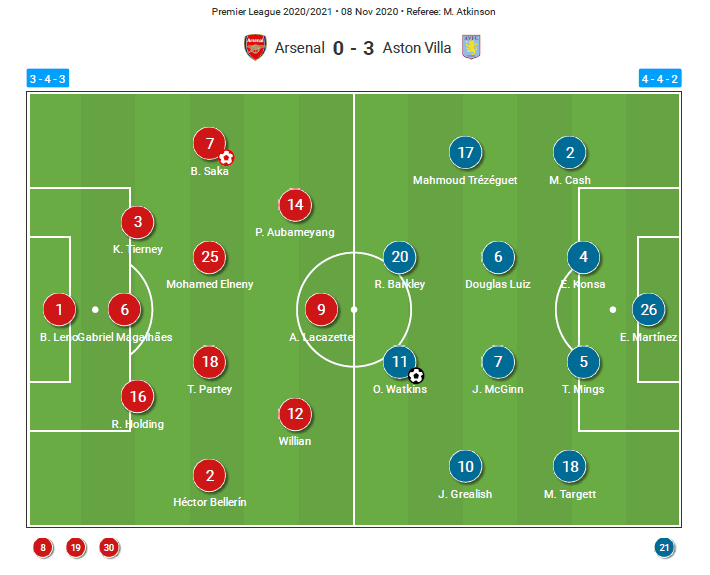
Arsenal: 3-4-3
Arteta started the same XI that triumphed away at Old Trafford the previous game week. Alexander Lacazette was the focal point of the attack while captain Pierre-Emerick Aubameyang supported narrowly from the left and Brazilian, Willian from the right. Thomas Partey and Mohammad Elneny controlled the tempo of their side from the middle while Bukayo Saka and Héctor Bellerín operated on the left and right flank respectively. Gabriel Magalhães was the centre of a back three accompanied by Keiran Tierney and Rob Holding either side while the tried and trusted Bernd Leno started between the posts.
Aston Villa: 4-4-2
Smith made one change to the side that fell to Southampton last week, Mahmoud Trézéguet comes back in place of Bertrand Traoré at right-wing. Watkins leads the line for his side with Grealish attacking from the left, Trézéguet from the right, while Barkley supports from behind as playmaker. Douglas Luiz and John McGinn control the game from centre-midfield, protected by a back four made up of Matt Targett, Tyrone Mings, Ezri Konsa and Matty Cash. Former Gunner who blossomed late in his career, Emiliano Martínez, is Smith’s preferred choice in goal.
A brief overview
We saw two sides with contrasting styles and tactics match up, both believing their strategy would give return success. This game was an excellent example to show that having the majority of possession does not make you more dangerous, and why you must have dynamism and variability in your attack to get success.
Arsenal, set up in a 3-4-3 that morphed into a 2-3-5 in the attacking third, and a 5-3-2 in the defensive phase. In possession, Arsenal’s wide players would make lateral rotations to unbalance the Villa defence, lose defenders and open passing lanes into the final third. Arsenal’s persistence to build through the thirds even in transitions meant Villa were offered time to get defensively organised to receive an attack. Villa’s low-block in the defensive phase meant the Gunner’s needed quick combinations or individual flair to get behind the defence, which on no occasion did Arsenal manage to do so.
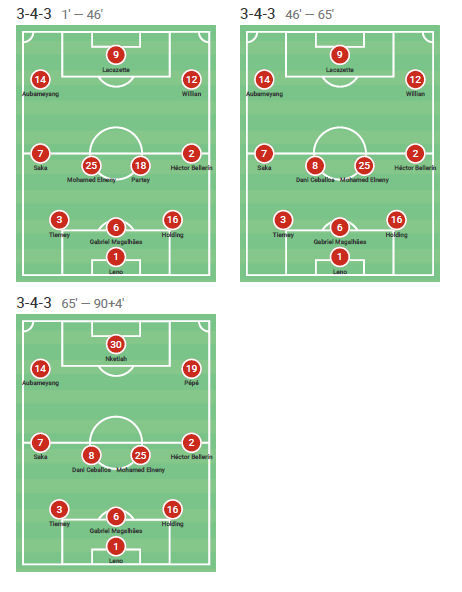
Above, we see Arsenal’s formations and substitutions across the 90+ minutes. The first change was made on 46 minutes, injured Thomas Partey vacates the field and is replaced by the attack-minded Dani Ceballos. On 65 minutes, two of Arsenal’s front three are withdrawn, Lacazette is replaced by the fresh legs yet less experienced Eddie Nketiah. At the same time, right-footed Willian made way for left-footed Nicolas Pépé who operated as an inverted winger cutting on from the right flank with a view of the goal.
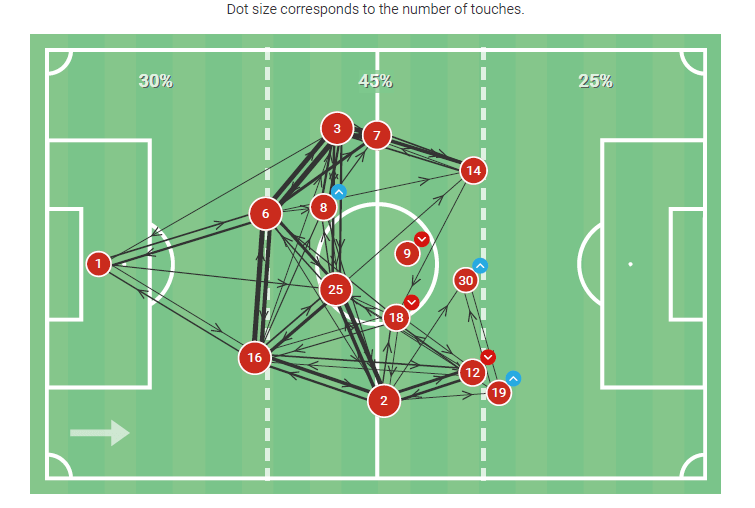
In the data above, we see Arsenal’s passing network in the final 60% of the field across 90 minutes. Accounting for combinations of three or more passes the dot size reflects a player’s touches on the ball. Observe the density of the lines between the back five and central-midfielders. We can see Arsenal were perhaps forced into wide areas when attacking, and perhaps more than they desired.
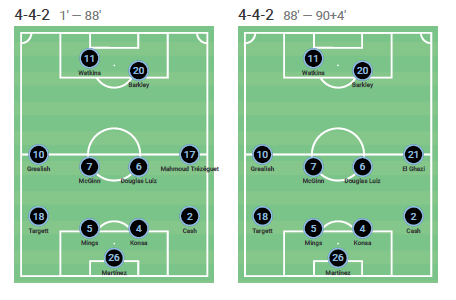
Aston Villa‘s formation is reflected as a 4-4-2, yet, there is a case to be made that this was more of a 4-2-3-1. When we account for the characteristics of the player’s, Smith’s side seemed to honour a system that played with a double-pivot, a central-attacking-midfielder and two mobile wingers who could move fluidly between the top two units. Aston Villa was intense and aggressive in the transitions, making it difficult for Arsenal to play forward when defending and looking to hurt Arsenal quickly when attacking. Smith set his side out to defend in a high-block during Arsenal’s build-up, whenever unsuccessful the Villan’s would occupy a low-block as Arsenal advanced.
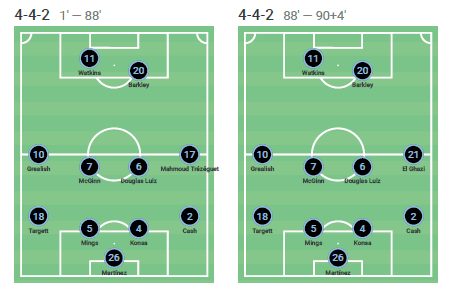
Above, we see Aston Villa’s formations and changes across 90+ minutes. Making only one change, at 88 minutes Trézéguet is withdrawn for Anwar El Ghazi in a like for like substitution. Both managers remained resolute in their formation and playing style for the entirety of the game.

In the data above, we see Aston Villa’s passing network in the final 60% of the field across 90 minutes. Accounting for combinations of three or more passes the dot size reflects a player’s touches on the ball. In contrast to Arsenal’s pass map, we see the lines are not as dense between defence and midfield, yet, the front three of Grealish, Watkins and Barkley show evidence of frequent combinations over short distances.
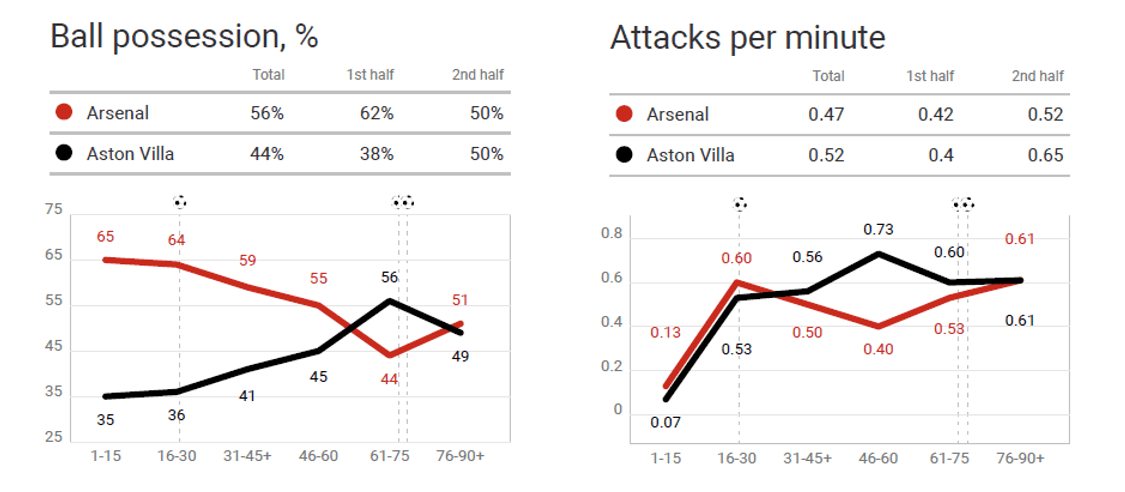
The above data shows ‘possession’ by team on the left and’ attacks per minute’ by team on the right. Something considerable to note here is although Arsenal has the majority of possession across the 90+ minutes, Aston Villa edge Arsenal on attacks per minute with 0.52 attacks per minute on average. This is usually indicative of a team that looks to play quickly on the break and very often forward in the transition to attack.
Let’s take a look below at perhaps the most prominent aspects of both teams style of play.
The Villans target missing wing-backs
Whilst analysing this game it was clear to see early in the first half that Aston Villa aimed to get success with quick transitions and counter-attacks, particularly in the channels vacated by the attacking wing-backs of Arsenal. The front four for Villa were effective in how they ran the balls in the channels while creating 2-v-1’s against the wide centre-backs of Arsenal.
This forced Kieran Tierney and Rob Holding, in particular, to delay in challenges and concede space against Aston Villa’s attackers as they held out for recovering defenders to support. As a result, the Villans were frequently able to reach the final third and attack an unbalanced Arsenal defence, oftentimes winning corners and free-kicks if not a chance on goal.
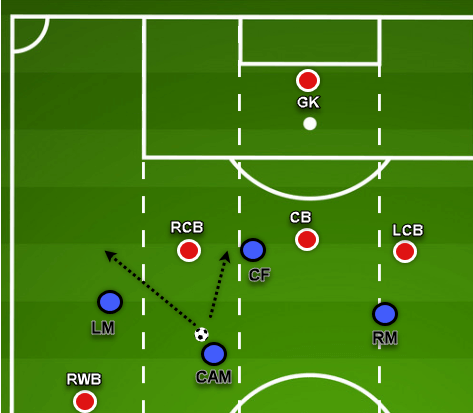
The above tactical illustration quite simple explains Aston Villa’s advantage in exploiting the channels. Above we see Both teams shape when Villa transition to attack. Note the complexity of the position for the ‘RCB’ Holding. By stepping out to engage the ball carrier or free player, he leaves space for Villa to penetrate. As a result, the nearside wing-back ‘RWB’ must recover quickly to nullify the attack.
Below is an example of this attacking strategy resulted in a goal.
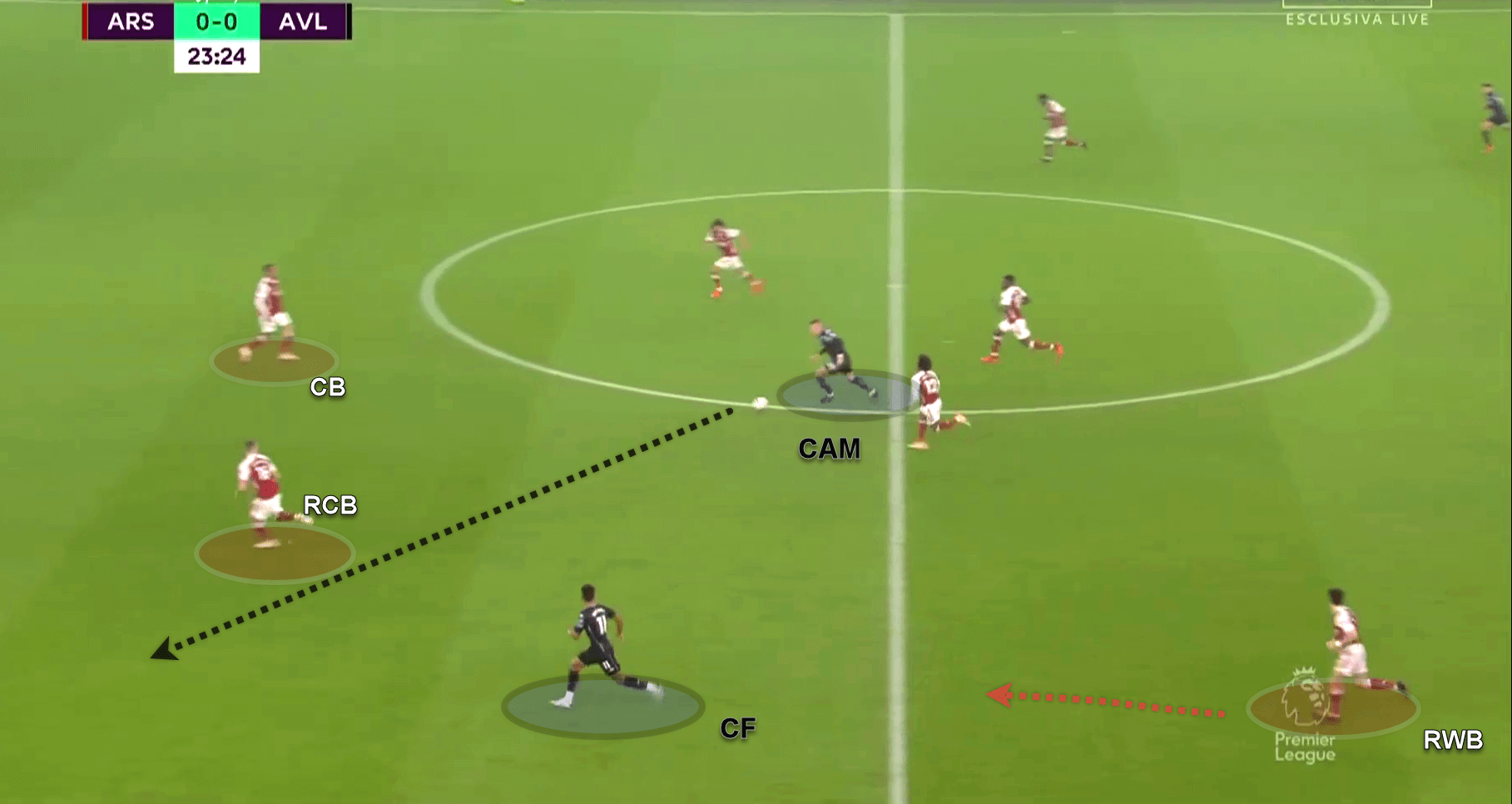
Barkley the ‘CAM’ wins a loose ball and dribbles forward in the transition to attack. Moments earlier the ‘CF’ Watkins moves out to the channel to provide a forward passing option. Before the ‘CAM’ is closed down, he releases a pass forward for the ‘CF’.
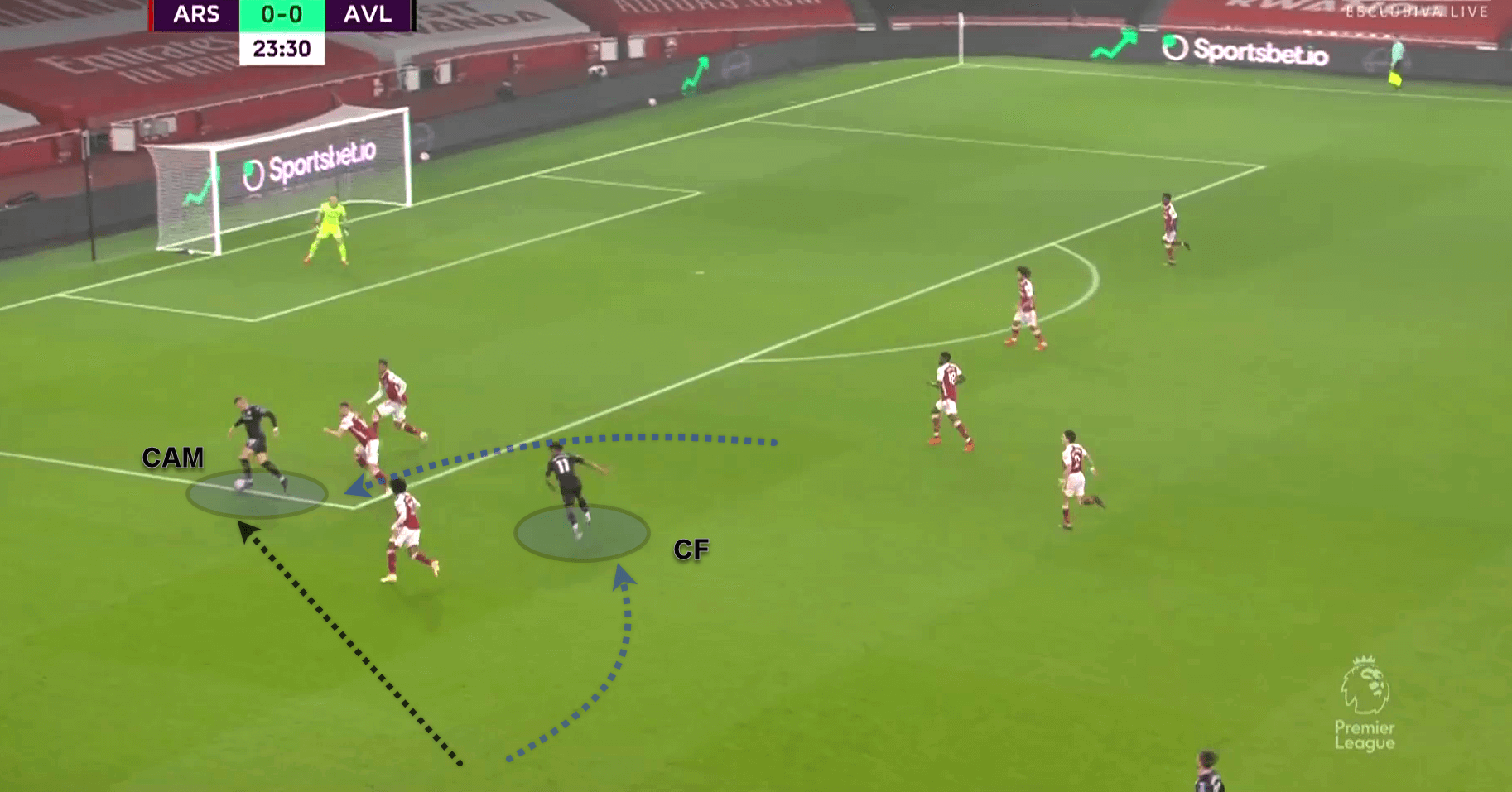
Watkins drives forward, and before he becomes isolated, he plays a forward pass to meet the in-to-out run of the ‘CAM’. At which point Barkley does well to hold the ball up, protect and dribble to create another passing angle as his teammates arrive in support.
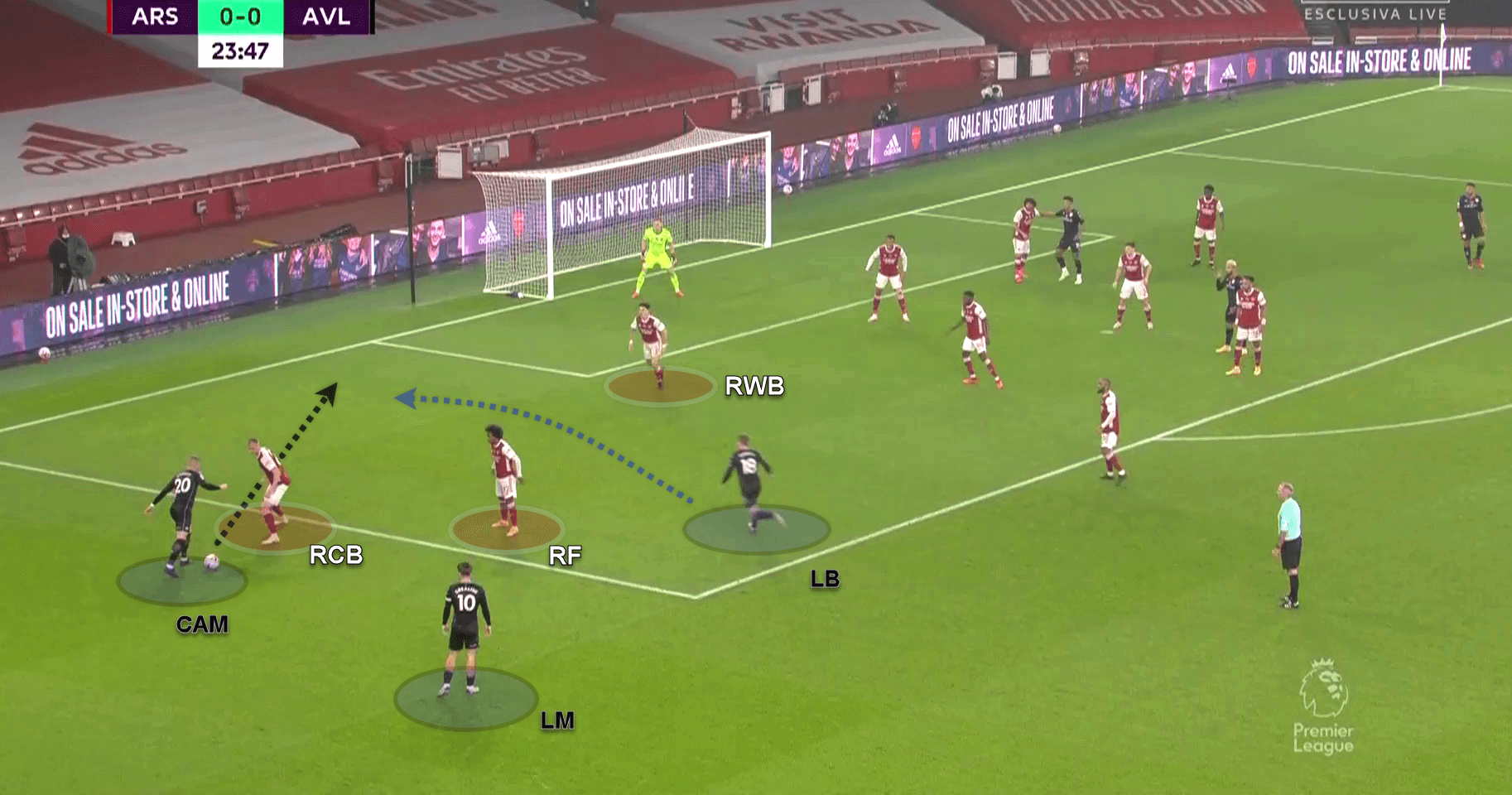
After playing a combination with the ‘LM’ Grealish, Barkley plays a forward pass to meet the underlapping run of the ‘LB’ Targett. It’s important to note. Barkley and Holding (Arsenal’s RCB) were posturing for six-seconds with no action before Barkley plays the pass.
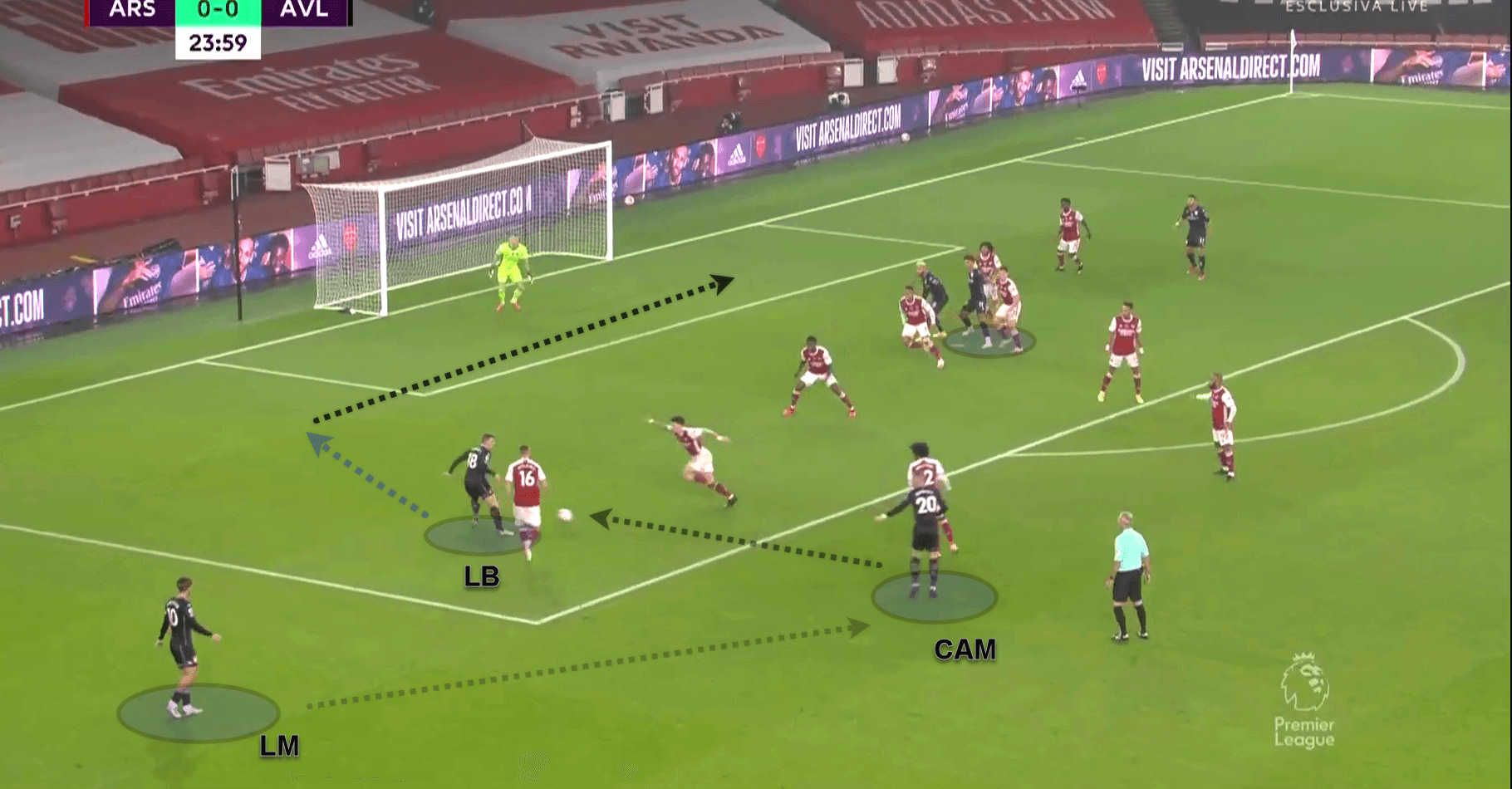
The ‘LB’ moments earlier received the ball in the box, dribbled back outside and played a short back pass to the ‘LM’. At which point ‘CAM’ moves away to take up a better position to receive a pass, while in that time the ‘LB’ gets back onside to make another run. The ‘CAM’ plays another forward pass to the ‘LB’ who then plays a hard and low cross into Arsenal’s six-yard box. Saka turns the ball into his own net while trying to defend the hard and low cross. 0-1 Aston Villa.
Aston Villa had a total of 31 wide attacks, not including the further 19 central attacks. From those wide attacks, only 50% resulted in an attempted cross. The Villans were confident in exploiting Arsenal’s defence in other ways such as by dribbling into the box or playing short and fast combinations to penetrate. Aston Villa had significant success on Arsenal’s right, as the blistering pace of Grealish and Watkins was perhaps too much for Arsenal’s Rob Holding who won only 42% of his defensive duels (12/5).
Gunners fail to fire in the final third
The Gunners at times are a sight to behold when they play out from the back against a high-press. At times they are one of the best in the Premier League, how they play one and two-touch combinations out of pressure while having central-midfielders who can receive, turn and dribble forward whilst being marked. However, it is when they reach the final third, Arteta’s men run out of road and seem to struggle to unlock the opposition defence.
Arsenal build-up in a 3-4-3 yet, as they play through the middle third the Gunners morph into what can be considered a 2-3-5. By having a player in each vertical channel, this serves to pin the opposition defence back, forcing them to withdraw players from midfield to match Arsenal by numbers. As well as having players who can move vertically and horizontally from these positions, they can easily unbalance the defence and create better opportunities to penetrate.
The danger to this style of play and repetitive action is that it makes Arsenal more predictable and easier to defend. Even in the transition to attack, Arsenal was more often happier to allow the opposition to drop back and defend while Arsenal take shape and build from the back patiently.
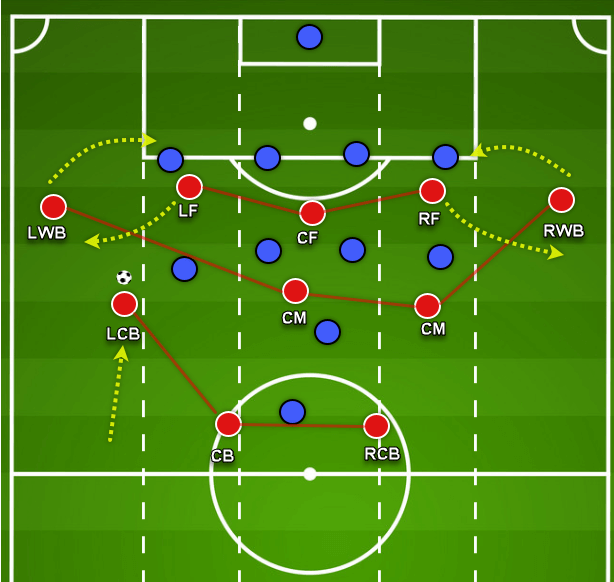
The tactical illustration above shows Arsenal’s 2-3-5 when balanced, while the yellow lines represent players primary movements in the final third. Note how ‘LCB’ Tierney will commit higher on the left while the ‘RCB’ Holding remains withdrawn.
Below is an example of how Arsenal build with fluidity from the back up to the final third only to have no reward for their endeavour.
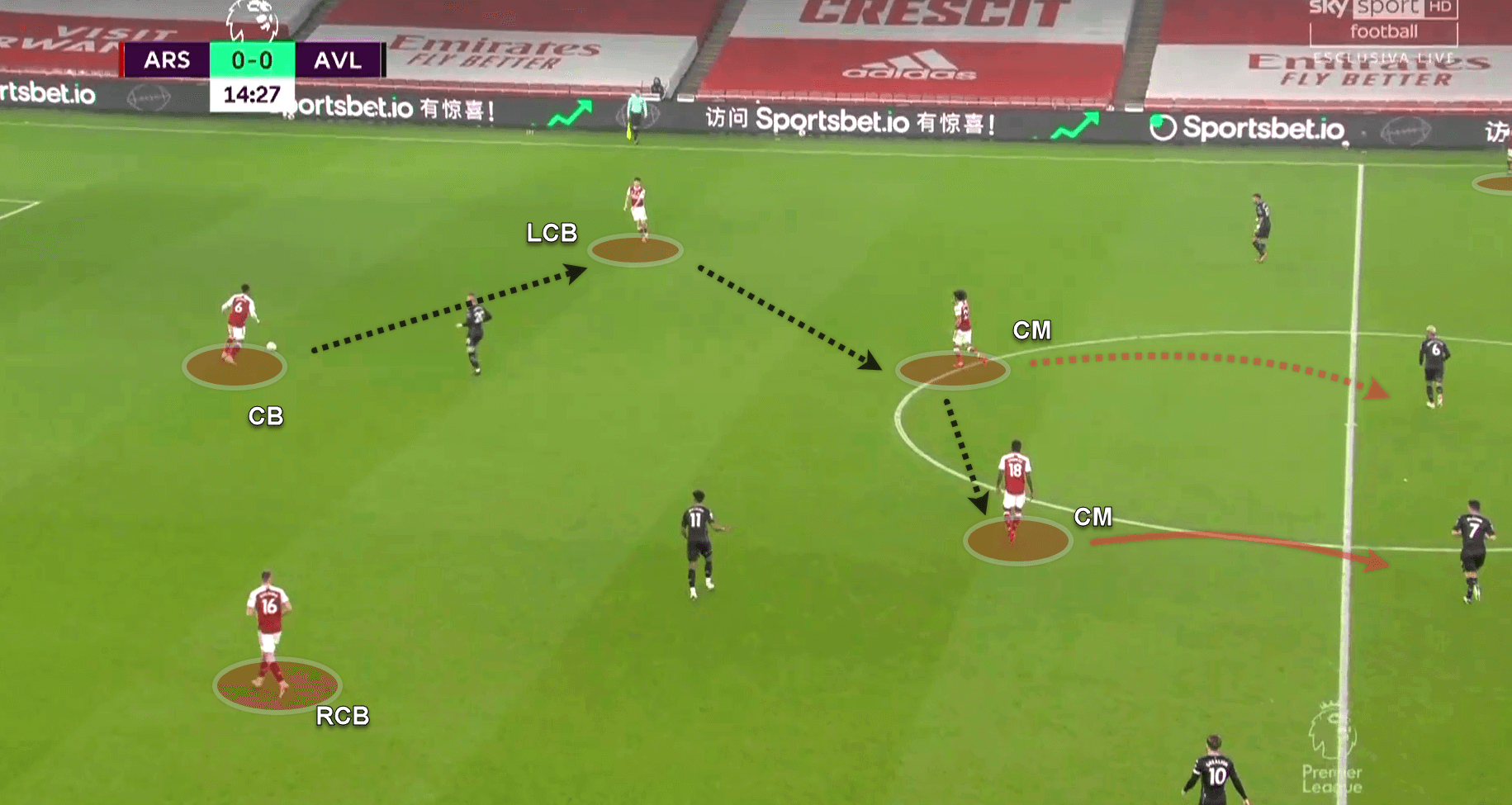
Above, we see Arsenal regain possession and look to build from the back against Villa’s high-block. The Gunners are out and attacking the final third within moments of a few passes. Gabriel plays to Tierney who then plays forward to Elneny, the Egyptian turns, passes to Partey and continues forward.
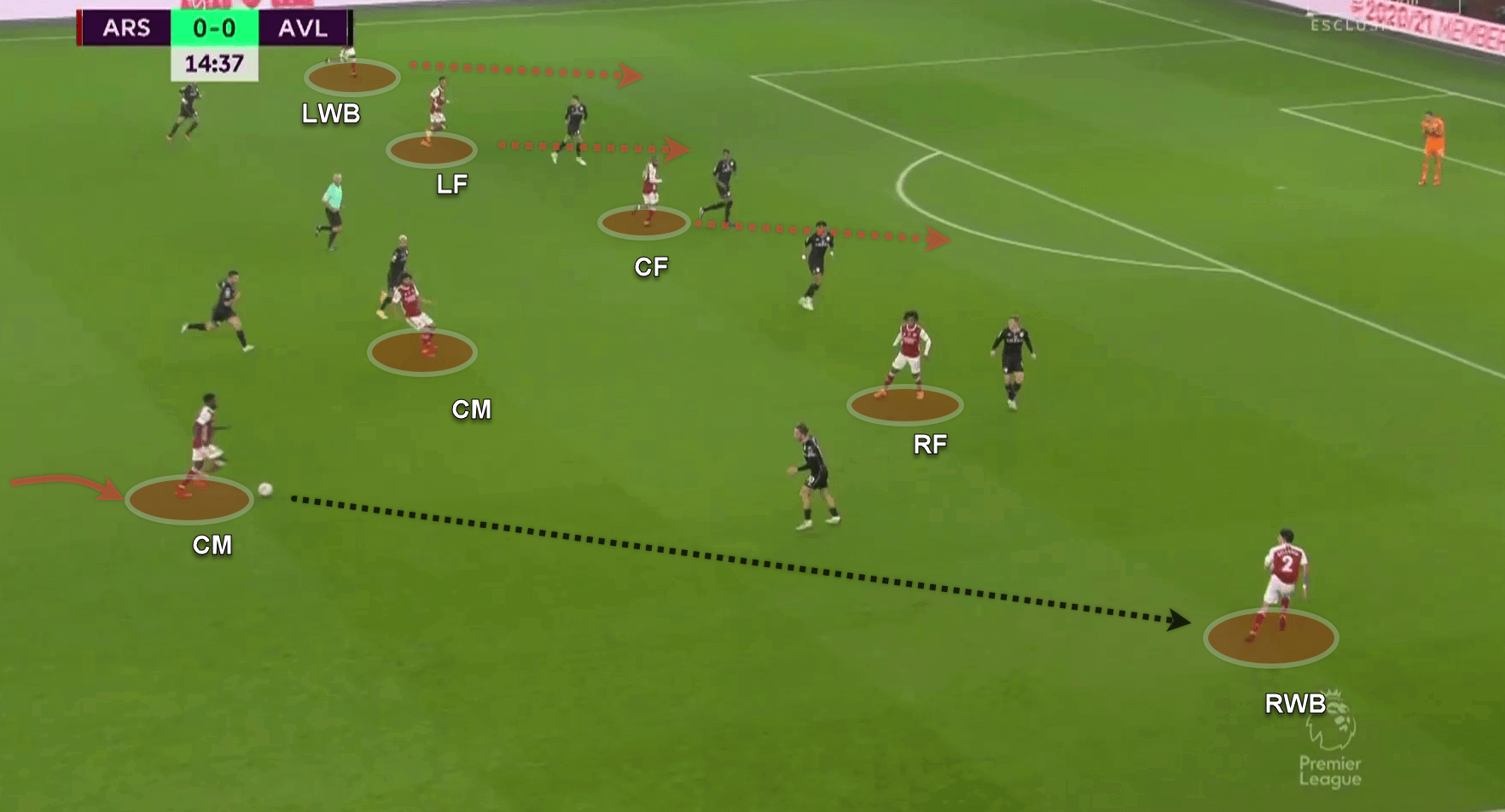
Partey, journey’s forward a short distance where the advanced wing-back Bellerín takes up a high and wide position to receive a forward pass.
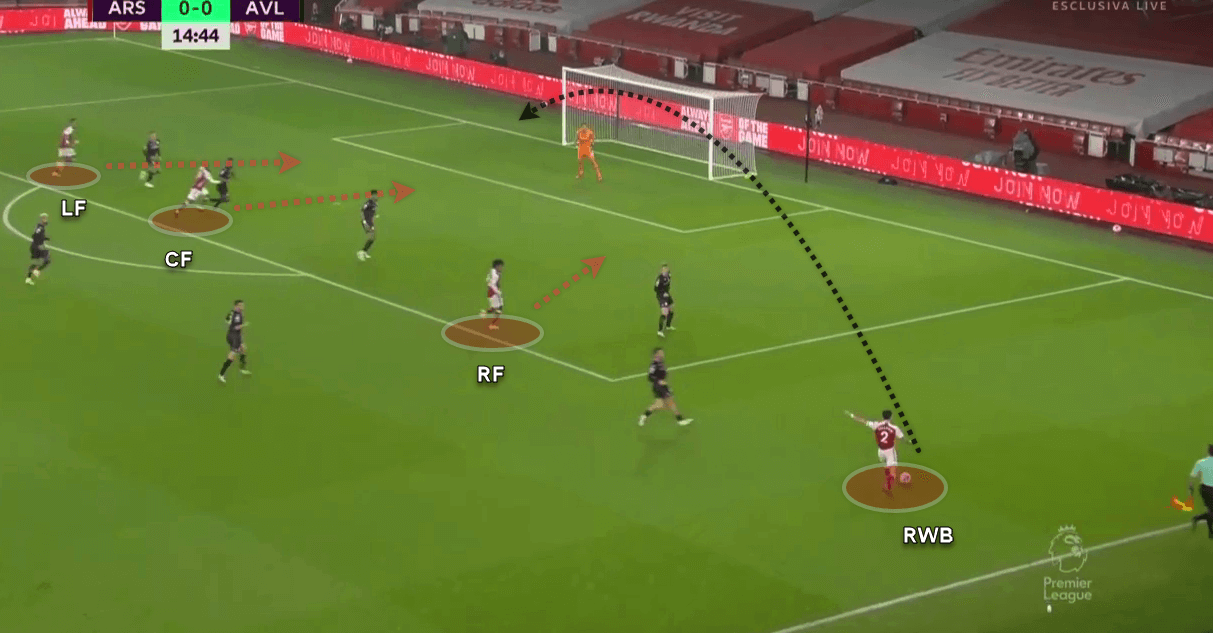
Bellerín takes a touch, adjusts himself and delivers an out-swinging cross to the centre of the six-yard box. Villa’s goalkeeper collects comfortably while even without his interference you get the sense Villa’s compact defence would have dealt with the challenge comfortably.
The Gunners attempted 26 crosses in the game, of which only 8 (31%) met a player in red, and from those perhaps only one seemed to trouble the goalkeeper. Arsenal conjured 34 attacks from open play, from those only 3 (9%) resulted with an attempt on goal.
Below is an example of how Arsenal struggled to penetrate and score from either side of the box against Villa’s centrally compact defence following a good spell of attacking play.
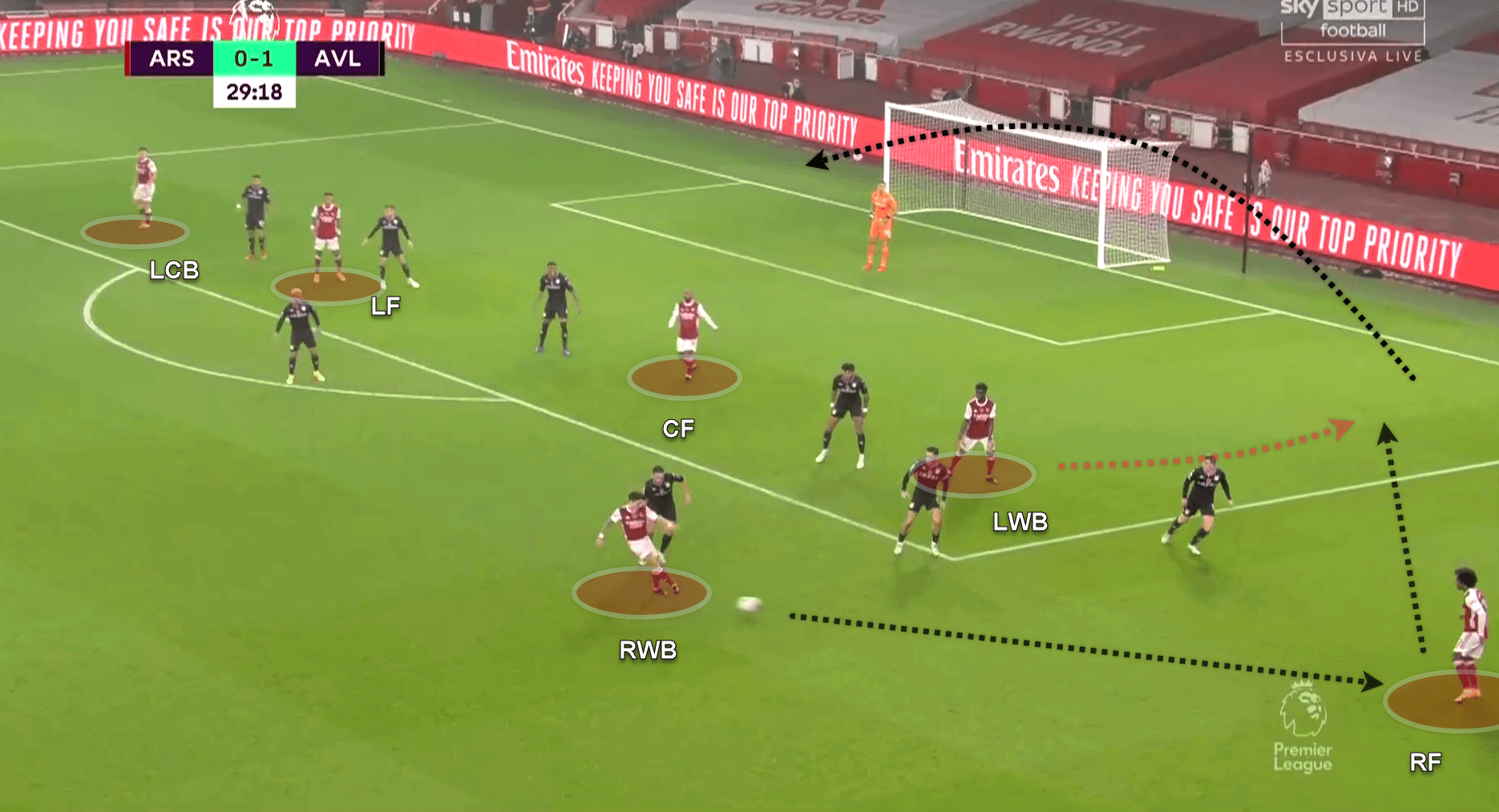
Above, Willian ‘RF’ receives a pass from the ‘RWB’, on his second touch; he plays a forward pass to meet the run of Saka in the half-space channel. Saka crosses the ball to the centre of the goal, at which point Mings the Villa centre-back makes good defensive header out of the box.
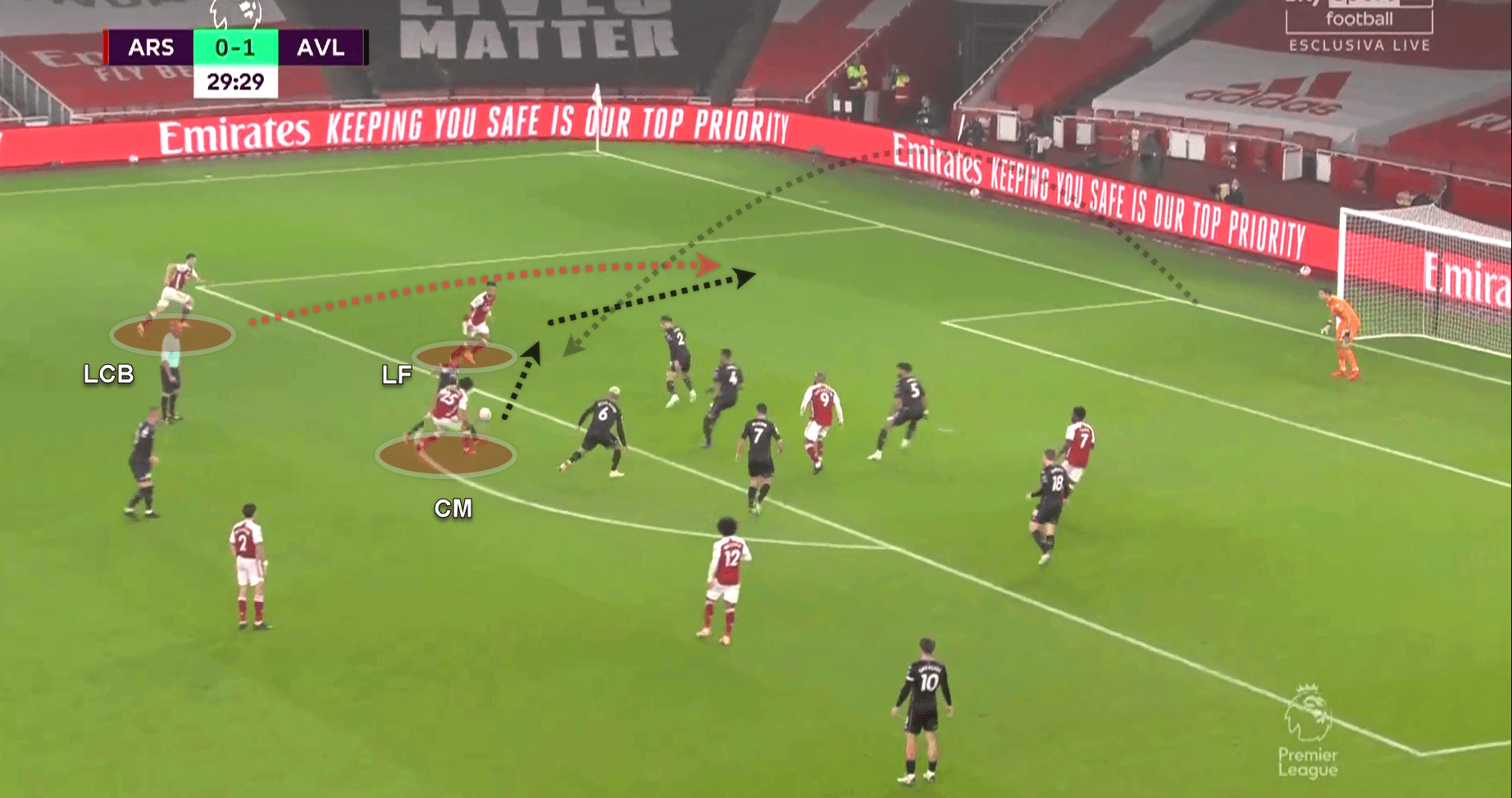
Elneny shrugs off a Villa midfielder as he picks up the second ball, Elneny then plays a pass to Aubameyang on his left. At the same time, Tierney makes an overlapping run beyond Aubameyang.
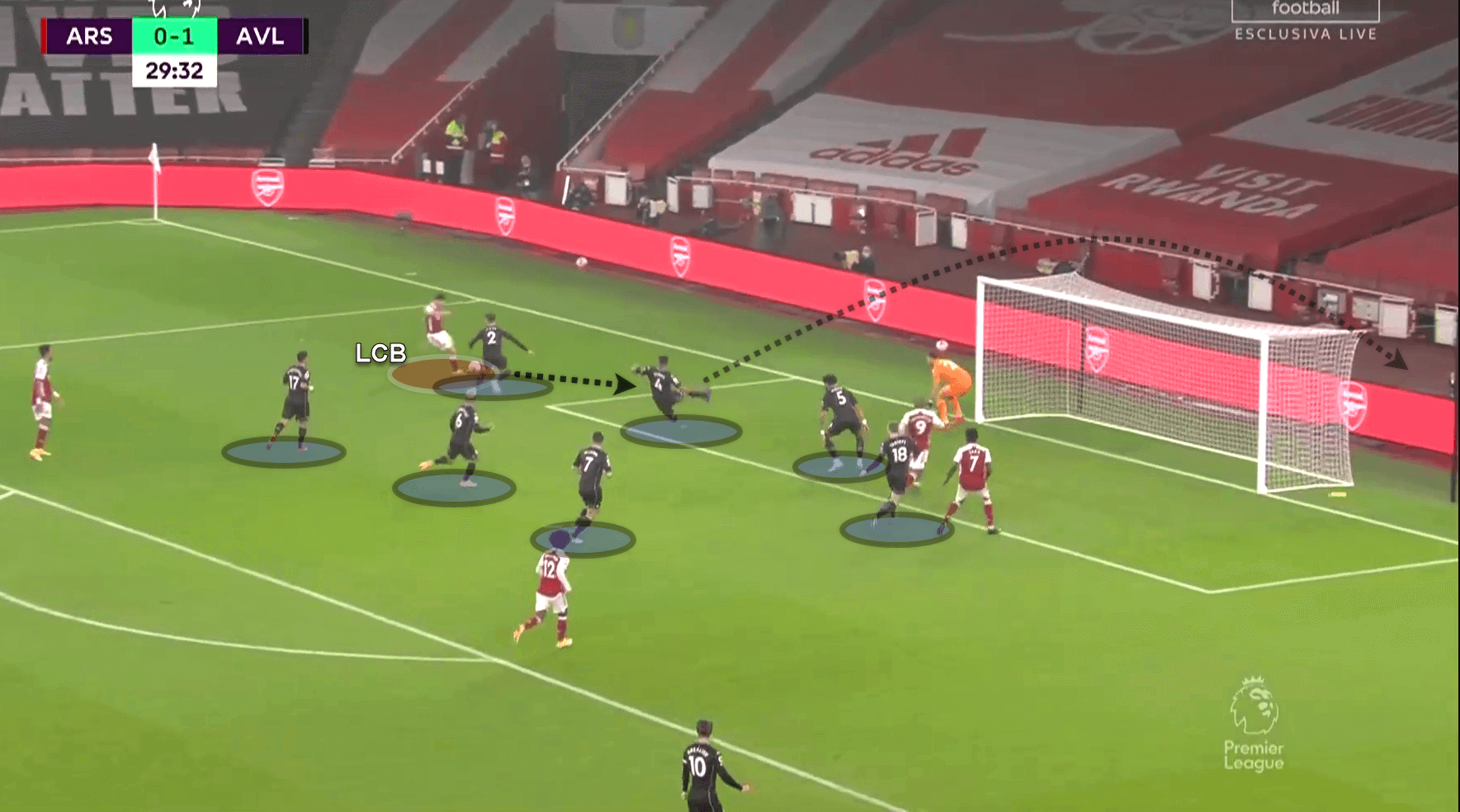
Aubameyang plays a pass forward to Tierney who then plays a hard and low cross on his first touch. Unfortunately, neither the attack nor the cross was quick enough to beat Villa’s recovering defenders, Konsa slides and blocks the cross before the ball reaches the goalmouth. This was perhaps Arsenal’s best phase in attack.
Arsenal enjoyed spells with 65% possession and averaged 56% across the 90 minutes. From all the possession The Gunners managed only 0.47 attacks per minute, inferior however slightly to Aston Villa’s 0.52 attacks per minute who averaged 46% possession. From a total of 14 attempts on goal, only 2 shots hit the target for Arsenal. Arteta’s side accumulated an xG of 1.39, still slightly inferior to Villa’s xG of 1.47.
Villa’s ball carriers undo Arsenal defence
Whether it was from a quick transition or in their offensive shape, Villa’s front four were superb at engineering chances and changing the point of attack from dribbling. Accounting for the ‘Dribbles / successful’ statistic, four of Aston Villa’s players ranked highly, and some double that of Arsenal’s highest attempted Dribbles (K. Tierney: 4 attempts/ 3 successful). Villa’s player’s stats were as follows; Grealish: 9 / 7 / 78%, Barkley: 8 / 8 / 100%, McGinn: 7 / 6 / 86% and Watkins: 6 / 5 / 83%.
In contrast to Arsenal, who seemed to progress their attacks and try to unlock the defence with passes, Aston Villa seemed to optimise an efficient balance of dribbling and passing to get success. Smith utilised his skilful ball carriers very well; the attackers were confident and quick when dribbling forward. Villa tallied up 4 counter-attacks from their half in contrast to Arsenal who attempted just one.
Below is an example of how Villa’s ball carriers got success by dribbling forward skilfully while under pressure, to create and finish a chance.
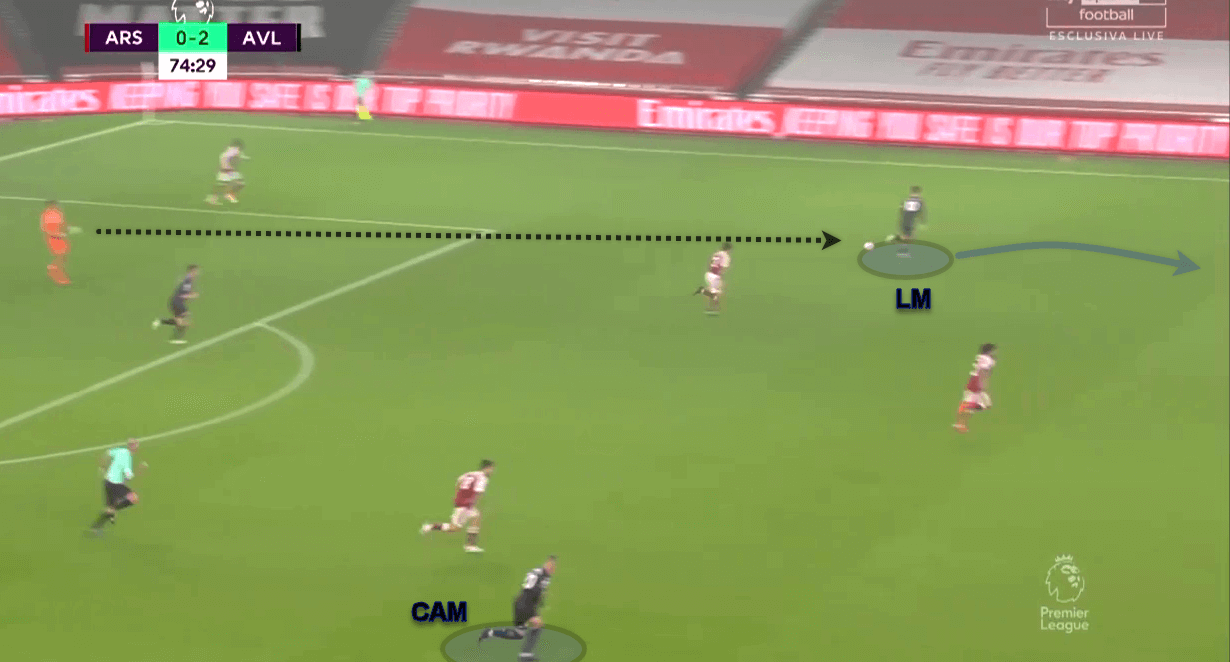
Above, Villa’s goalkeeper rolls out a ball quickly to the path of ‘LM’ Grealish as they look to counter-attack. Grealish drives forward with the ball at top-speed as the recovering Arsenal defenders struggle to close the gap.
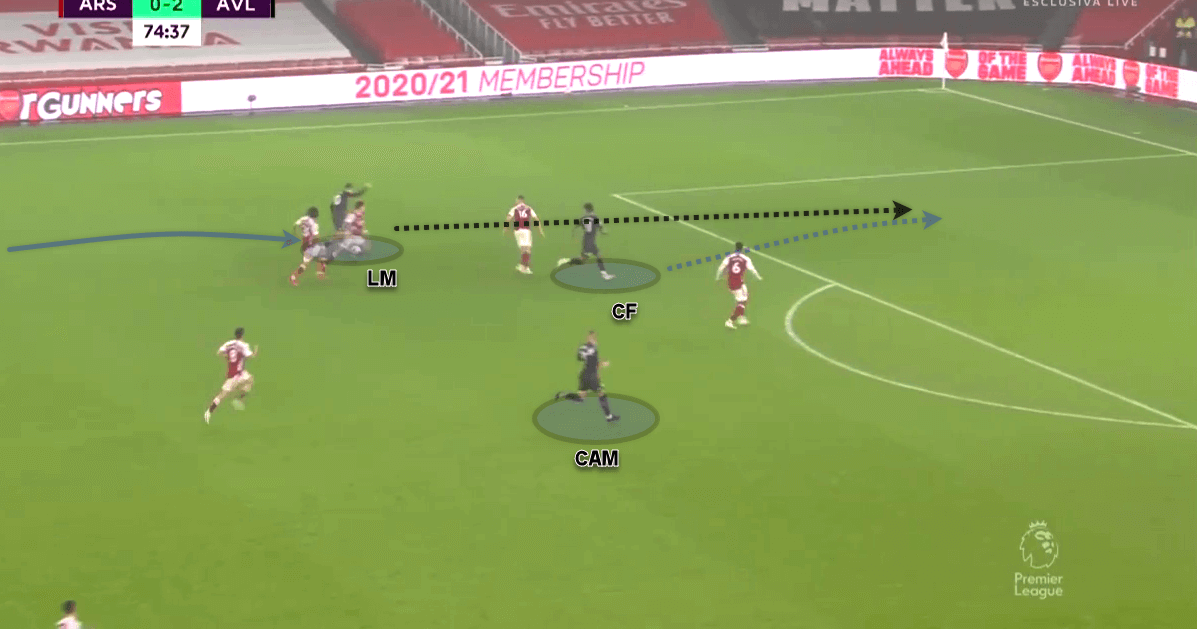
Grealish gets within 10-metres of the goal before playing a through ball to meet the run of Watkins. Even before passing, Grealish does well to body a challenge from the Arsenal defender who he sees off comfortably while protecting the ball.
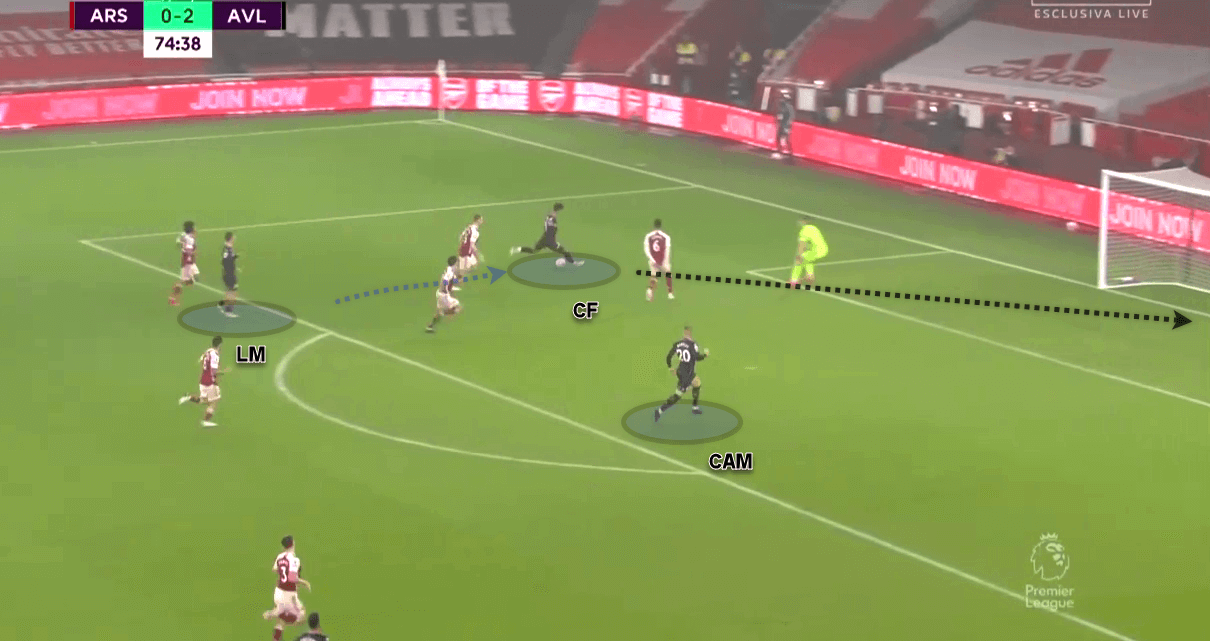
Watkins adjusts his body, gets a view of the goal and finishes low past Leno. Notice the ‘CAM’ Barkley offers himself in an excellent position to receive a pass and finish in an empty net, however on this occasion, he was not needed.
Considering Villa’s danger in attack and ultimate success as a result of dribbling and attacking actions in 1-v-1’s, I was a little surprised to see not one Arsenal player received a booking. No, that does not necessarily correlate with good defending. Yet, when your defence is getting undone by quick attackers dribbling to create chances, perhaps some spirited challenges when there is little chance of winning the ball is sometimes required to stop the bleeding.
Conclusion
The scoreline is not a fair reflection of both sides performances; a degree of good fortune can be considered for Aston Villa. However, it seemed that by hook or by crook the Villans would come away worthy winners, as Arsenal did little to improve their attacking potential while Smith’s men had so much in abundance to hurt Arsenal with, and they did.
It’s reflection time for Arteta and his staff as they assess this past weekends performance. It would not be unfair to say a result like this was likely to happen against a strong counter-attacking side for Arsenal. Even in games, the Gunners are winning lately, they seem to be very lucky to score considering they struggle to create many chances. Still, Arteta has brought the team forward since his arrival ten months ago, for all that he has accomplished in that time, I think he will improve his side’s ability to penetrate and beat the low-block.
Similarly, Smith has done a remarkable job to date as his second season could not have got off to a better start. Villa seems to have a different identity this season, yes key signings have made an enormous difference at both ends of the field. Chief among them, Ollie Watkins, who is an ever-present threat in front of goal along with Ross Barkley who gives them something new going forward.
Both managers will be hoping for all players to return injury-free as the players break now for international duty. To track the progress of both of these sides when they return to Premier League action, be sure to check back in with us at Total Football Analysis.

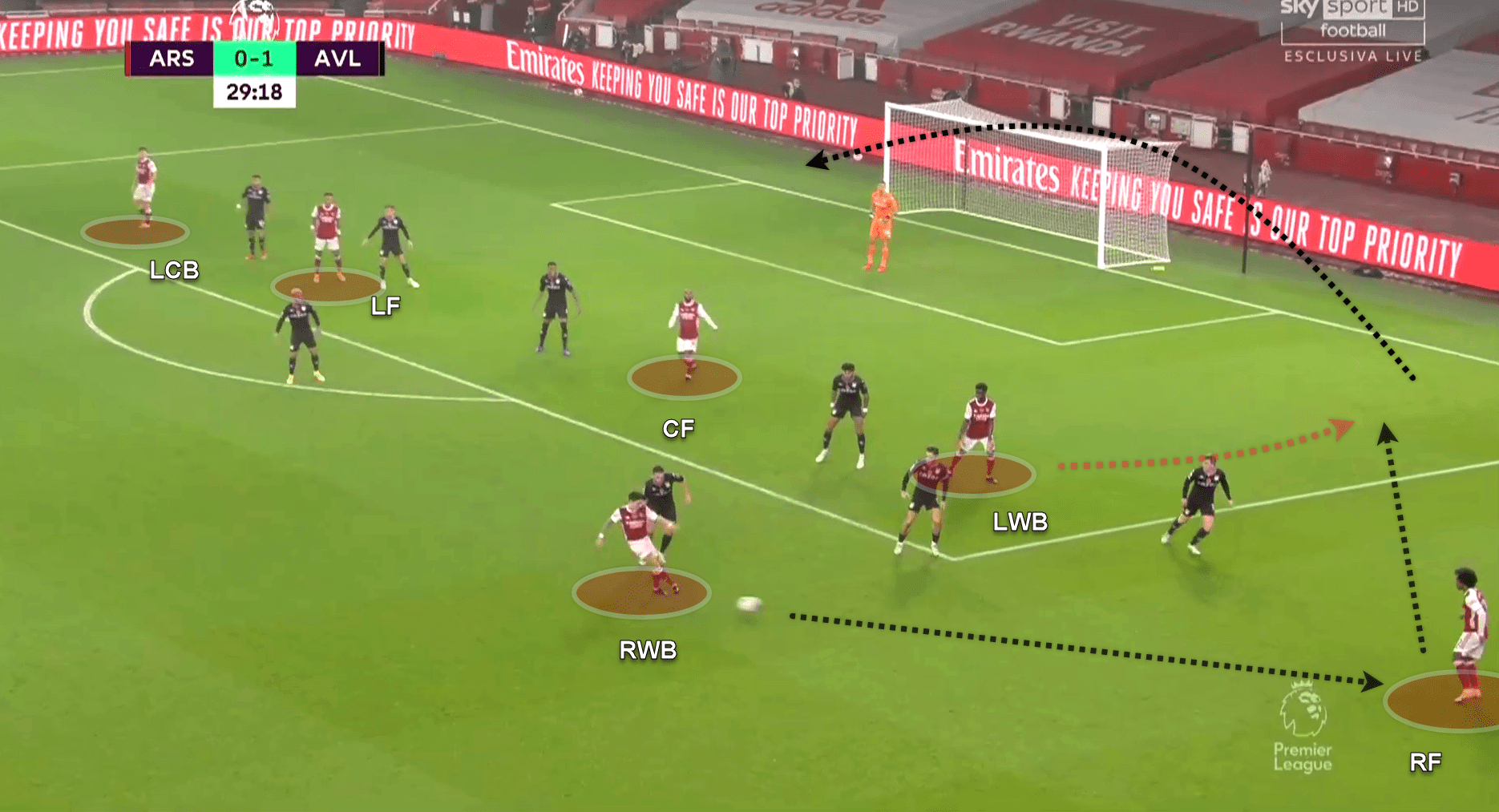



Comments